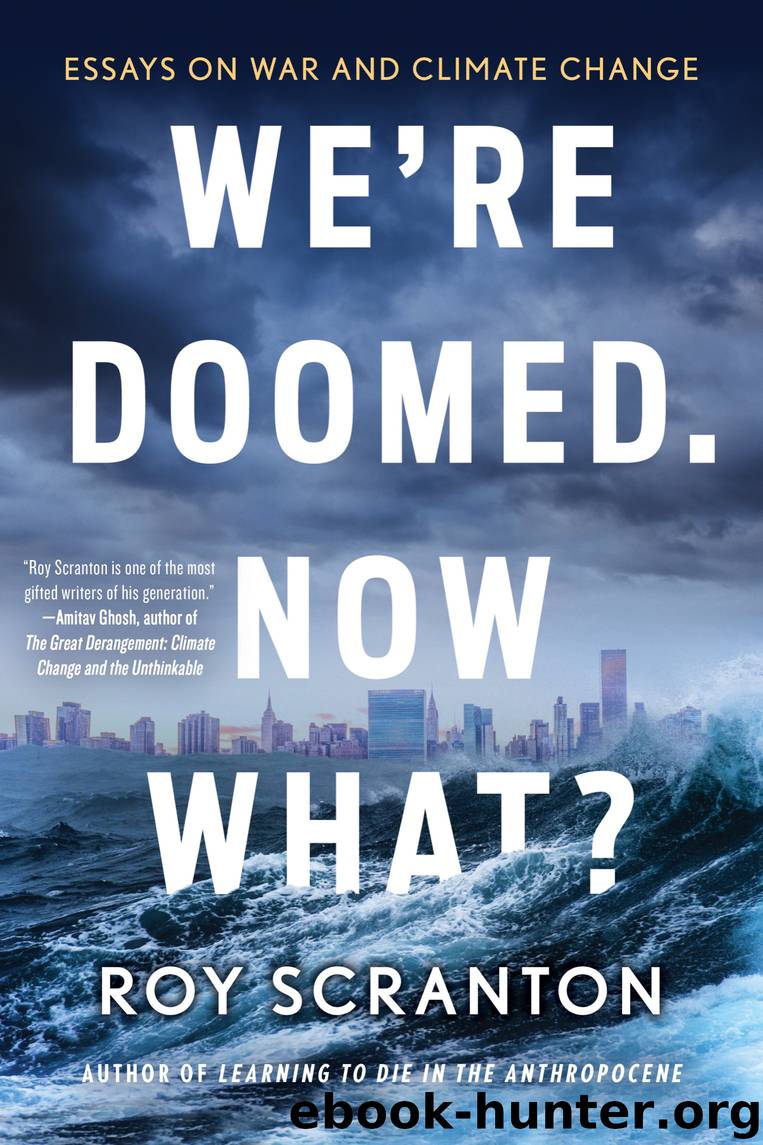We're Doomed. Now What? by Roy Scranton

Author:Roy Scranton
Language: eng
Format: epub
Tags: Essays, Non-Fiction
Publisher: Soho Press
Published: 2018-07-17T16:41:13+00:00
The dream I had of Mutanabbi Street was a dream that life could win out over death, as the poet Naseer had said a few days ago: a faith that the tissue of existence was stronger than the ravages of imperial politics or religious violence. I wanted to believe it was true, and I wanted to believe that even in the darkest days, some flame flickered. Before coming to Baghdad, I had been lucky enough to meet Hassan Blasim, an Iraqi writer whose short-story collection, The Corpse Exhibition, took the perverse cruelty of thirty years of war and tyranny and turned it into art. The collection’s title story is about just what it says, a corpse exhibition by an artist who sculpts death, murdering people and arranging their bodies in grotesquely aestheticized positions. Blasim’s work isn’t the kind of redemptive bullshit you often get when people “turn suffering into art.” His stories are as cruel as the cruelty they portray, and they redeem no one and nothing. Yet somehow, even though his work offered no redemption, the mere fact of its existence, the fact that the human imagination had transformed horror into something beautiful was some kind of testament to the human spirit. Blasim’s work isn’t redemptive but rather tragic, and like the best tragedy, affirms life even at its most awful.
But Blasim had escaped. He lived in Finland now. There were artists, writers, and poets who hadn’t, still living in Baghdad, still writing and working. Indeed, while I was there, the Iraqi novelist Ahmed Saadawi won the 2014 International Prize for Arabic Fiction for his gothic novel of wartime life, Frankenstein in Baghdad. The novel’s plot is a metaphor for artistic life in Iraq today: a scavenger named Hadi begins to collect pieces from the unidentified corpses of bomb victims, stitching them together into one body so that they could be properly buried. Before he has a chance to bury the monstrosity, however, it comes to life, and begins a rampage of vengeance, hunting down the killers who had murdered the various people its body was now composed of.
Another artist I met, a playwright and sculptor named Sarem Dakhel Ahmad, who had spent seven long years in the Iraqi Army during the Iran-Iraq War and the Persian Gulf War, thought of his art not as cruelty but as catharsis. “The curse of war has polluted my life . . . but after getting out of the army, I started making art as a way to purge the pollution. I think of my art as a practice of purification.” Under Saddam’s regime, he had been investigated for staging Samuel Beckett’s Waiting for Godot, and had had a play of his own, The Night of Murder, banned. After the fall of the regime, he was threatened by religious extremists. One day he received an envelope with a note and a bullet. The note read: “Stop making sculpture.” He kept on making art, though he did take advantage of a fellowship offered by a Russian art institute to spend some time outside the country.
Download
This site does not store any files on its server. We only index and link to content provided by other sites. Please contact the content providers to delete copyright contents if any and email us, we'll remove relevant links or contents immediately.
The Rules Do Not Apply by Ariel Levy(3897)
Bluets by Maggie Nelson(3704)
Too Much and Not the Mood by Durga Chew-Bose(3689)
Pre-Suasion: A Revolutionary Way to Influence and Persuade by Robert Cialdini(3404)
The Motorcycle Diaries by Ernesto Che Guevara(3325)
Walking by Henry David Thoreau(3227)
What If This Were Enough? by Heather Havrilesky(2943)
The Day I Stopped Drinking Milk by Sudha Murty(2851)
Schaum's Quick Guide to Writing Great Short Stories by Margaret Lucke(2796)
The Daily Stoic by Holiday Ryan & Hanselman Stephen(2703)
Why I Write by George Orwell(2354)
Letters From a Stoic by Seneca(2329)
The Social Psychology of Inequality by Unknown(2304)
A Short History of Nearly Everything by Bryson Bill(2131)
Feel Free by Zadie Smith(2094)
Insomniac City by Bill Hayes(2080)
A Burst of Light by Audre Lorde(1978)
Upstream by Mary Oliver(1931)
Miami by Joan Didion(1877)
